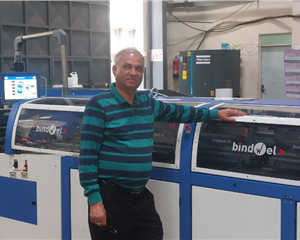Paper industry in India is not cutting forests: Saurabh Bangur
The following is the transcript of the speech delivered by Saurabh Bangur, president, Indian Paper Manufacturers Association (IPMA) on the Paper Day event held on the sidelines of Paperex on 1 November 2017, at Pragati Maidan, New Delhi.
14 Nov 2017 | By PrintWeek India
It gives me great pleasure to be present here today at the launch function of Paper Day. On behalf of the Indian Paper Manufacturers Association (IPMA), I offer my compliments to all the supporting organizations who have come together to launch this unique and significant initiative.
Friends, world over, there is a move to rediscover the benefits of using paper. Not only that, the world at large has also come to appreciate the environment-friendly stance of the paper industry. According to reports, a large number of big corporate, including Fortune 100 companies have let go of the message – ‘reduce paper and save the environment’ — in their communication. Today, the use of paper is not being considered as an impact on the Environment, while the usage of paper in education is also being re-valued. It is being appreciated and well accepted of the fact that retention levels are much higher when studied from the paper, instead of the digital medium. IPMA is making efforts that this contribution of paper as a biodegradable, recyclable and sustainable product which is basic to education gets noticed widely in India too.
Unlike in some parts of the world, the paper industry in India is not a forest-based industry but is an agro / farm forestry based. That is, like any other crop, farmers grow trees on their lands and sell their harvest to the paper mills.
India’s paper industry has strong backward linkages with the farming community, from whom wood is sourced. Pioneering work has been carried out by the industry over the last decade in producing tree saplings, which are disease and drought resistant and can be grown in a variety of agro climatic conditions.
There is no truth in the argument that claims ‘use less paper and save the environment’. Paper industry in India is not cutting forests. As opposed to the perception, the industry has been encouraging growing of trees at a fast pace by the farmers for sourcing wood. Intensive efforts mounted by the paper mills over the last several years have been instrumental in influencing plantation on cumulatively 900,000 hectares approximately on an all India basis.
Growing trees by the industry is leading to absorption of carbon dioxide and helping the cause of mitigating climate change. Industry has also earned carbon credits for this agro forestry initiative. What is significant to note is that young trees grown absorb more carbon dioxide than the aged ones. Thus, usage of paper is good for the environment. These working or managed forests are very useful for the environment, and the Industry has demonstrated potential to enlarge the country’s green cover.
Paper and paperboards also provide a much more environment-friendly and better packaging material than alternate materials like plastic.
To summarise, paper is biodegradable, renewable, recyclable and sustainable, made from planted trees. Growing and harvesting trees provides jobs for lakhs of people. Working forests support the environment, providing clean air, clean water through increased rainfall, wildlife habitat and carbon storage.
The Industry has been closely associated with the national objectives of greening India, rural employment, and usage of sustainable resources, besides meeting paper needs of the Indian consumers.
Indian paper industry has made huge investments in the recent past to upgrade and implement clean and green technology, product quality, farm forestry, etc and more investments are in the pipeline.
To conclude, I would like to thank the organisers for taking the initiative and creating this platform and concept of Paper Day. I wish you all success and hope this effort of spreading the proper awareness of the industry is widely accepted.














 See All
See All